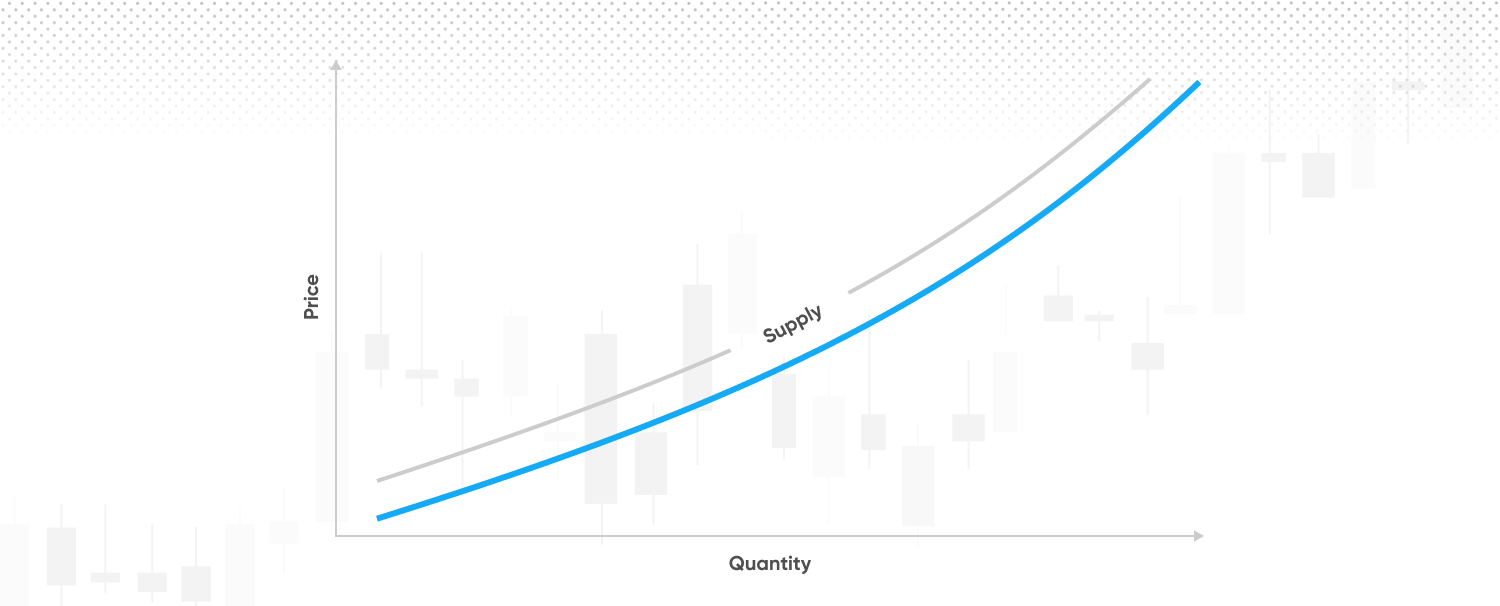What is supply?

Supply in economics is the quantity of a particular product or service that suppliers offer to consumers at a specified price at a certain period of time.
Below, we have the concept of supply explained in detail.
Key takeaways
-
The definition of supply is that it is the total amount of a good or service available on the market.
-
The law of supply states that an increase in the price of a good leads to an increase in its supply.
-
The factors that can affect supply include, among others, demand, production costs, price, availability of resources, technological advances and government policies.
-
Supply and demand are fundamentally linked.
What is supply in economics?
Supply is a fundamental economic concept. It represents the total amount of certain goods available to consumers. Supply of a product tends to increase if a price goes up because companies want to expand their production to meet the increasing demand.
The concept of supply is closely related to the concept of demand, which is how much people want a particular product or service that suppliers offer consumers at a particular price at a specific point in time.
Understanding the concept of supply
There are three key features of supply. These include:
-
Quantity supplied: The amount of a good or service that producers are willing and able to offer for sale at a specific price.
-
Time frame: The period over which the supply is measured. In the short term, the supply may be fixed due to factors such as limited production capacity. In the long term, producers can adjust their production levels.
-
Price: The relationship between price and quantity supplied is inverse, meaning that as the price of a good or service increases, the quantity supplied also increases, and vice versa.
A key part of understanding supply is knowing the law of supply. It states that, as the price of a good or service increases, suppliers will increase their supply so they can increase their profits.
To better understand this, let's take a look at the supply curve. This is an upward sloping graph which indicates that, as the price goes up, the amount supplied also increases. The supply curve is derived from the supply schedule, which is a table that shows the relationship between the price of a good or service and the quantity supplied.

What is the relationship between supply and demand?
When the supply of a good or service is greater than the demand, prices tend to fall as producers compete for buyers. On the other hand, when the demand for a good or service is greater than the supply, prices tend to rise as buyers compete for the limited supply.
| Supply | Demand | Price | Market |
| Unchanged | Increases | Increases | Shortage |
| Unchanged | Decreases | Decreases | Surplus |
| Increases | Unchanged | Decreases | Surplus |
| Decreases | Unchanged | Increases | Increases |
Prices play a critical role in balancing supply and demand. As prices rise due to increased demand, producers are incentivised to increase their supply to take advantage of the higher prices. As supply increases, prices tend to fall, which in turn can stimulate more demand.
The equilibrium point is a price where both supply and demand meet, meaning that there is neither an excess supply nor an excess demand. This usually means that prices end up stabilising around the equilibrium point as there is no pressure for them to fall or rise.
What are the different types of supply?
Market supply
The total supply of a good or service by all producers or sellers in any given market.
Short-term supply
The supply of a good or service in the short run, when some inputs used in production cannot be adjusted. In a short period of time, a producer may not be able to increase the supply of a good or service in response to changes in demand.
Long-term supply
The supply of a good or service in the long run, when all inputs used in production can be adjusted. Over a longer period of time, a producer can increase or decrease the supply of a good or service in response to changes in demand.
Joint supply
A single good or service is produced together with another good or service. In other words, the production of one good or service results in the automatic production of another good or service.
Composite supply
A single product can be used for multiple purposes or can be sold to different markets. The supply of the product is therefore influenced by the demand for each of the different uses or markets.
Elastic supply
The supply of a good or service that is highly responsive to changes in price. When the price of a good or service increases, producers can quickly and easily increase the supply to meet the higher demand.
Inelastic supply
The supply of a good or service that is not very responsive to changes in price. When the price of a good or service increases, producers may not be able to increase the supply in the short run, leading to a shortage and higher prices.
Factors affecting supply
There are a number of factors which can have an impact on supply. These include, but are not limited to:
-
Demand. An increase in demand can eventually lead to an increase in supply, while a reduction in demand can eventually lead to a decrease in supply.
-
Cost. If a good or service is cheap to produce and/or provide, the likelihood is that there will be more of it. Likewise, if it is expensive, then the likelihood is that there will be less of it.
-
Price. If a product’s market price is comparatively high, that can mean that its maker or supplier could be motivated to make more of it. On the other hand, if it is not profitable enough, less of it is likely to be made available. Likewise, if a competitor product’s price goes up, that could reduce demand, meaning there is less supply and if it goes down that could increase demand, thus leading to a higher supply.
-
Technological advancement. Improved production efficiency and lower costs can boost supply but if new technology makes a product or even a whole industry obsolete, that can lower supply.
-
Number of sellers in a market. If there are a high number of sellers, that means the supply will likely rise, but if there is a low number, then the chances are that the supply will be low.
-
Government policies. Taxes, subsidies and regulations can have an impact on supply. To use a couple of extreme examples, a low-tax, low-regulation industry that is heavily subsidised will probably have a higher level of supply than one which is highly-taxed, heavily regulated and unsubsidised.
Conclusion
Supply is a crucial concept in economics. It is the amount of products available on the market at any one time, and is linked to the concept of demand. It is usually measured on a supply curve. There are many kinds of supply, including long-term, short-term, elastic, inelastic, and market supply.
Understanding supply, along with demand, is important as it is fundamental to understanding the functioning of markets and the distribution of resources.
FAQs
What does supply mean in economics?
In economics, supply is the quantity of goods and services that producers are willing and able to offer for sale at a given price.
What is an example of supply?
An example of supply is the amount of widgets that a factory produces in a given period of time.
What factors affect supply?
Some of the factors that affect supply include price of a product/service, cost of production/distribution, number of suppliers, technological advancement and government policies.